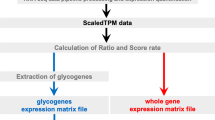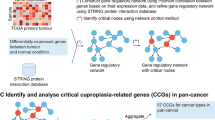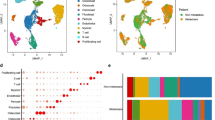Abstract
Genomic features have been gradually regarded as part of the fundamentals to the clinical diagnosis and treatment for gastric cancer. However, the molecular alterations taking place during the progression of gastric cancer remain unclear. Therefore, identification of potential key genes and pathways in the gastric cancer progression is crucial to clinical practices. The gene expression profile, GSE103236, was retrieved for the identification of the differentially expressed genes (DEGs), followed by gene ontology (GO), Kyoto Encyclopedia of Genes and Genomes (KEGG) enrichments, gene set enrichment analysis (GSEA) and the protein-protein interaction (PPI) networks. Multiple bioinformatics platforms were employed for expression and prognostic analysis. Fresh frozen gastric cancer tissues were used for external validation. A total of 161 DEGs were identified from GSE103236. The PPI network-derived hub genes included collagen type I alpha 1 chain (COL1A1), tissue inhibitor of the metalloproteinases (TIMP1), Secreted Phosphoprotein 1 (SPP1), somatostatin (SST), neuropeptide Y (NPY), biglycan (BGN), matrix metallopeptidase 3 (MMP3), apolipoprotein E (APOE), ATPase H+/K+ transporting alpha subunit (ATP4A), lysyl oxidase (LOX). SPP1 (log rank p = 0.0048, HR = 1.39 [1.1–1.75]) and MMP3 (log rank p < 0.0001, HR = 1.77 [1.44–2.19]) were significantly associated with poor overall survival. Stage-specifically, both COL1A1 and BGN were correlated with significant in stage III and IV gastric cancer cases. LOX showed significant correlation with prognosis in stage I and stage II gastric cancer cases. Furthermore, cg00583003 of SPP1 and cg16466334 of MMP3 exhibited highly methylation level and significant prognostic values (SPP1: HR = 1.625, p = 0.013; MMP3: HR = 0.647, p = 0.011). Hub genes signature displayed a favorable prognostic value (p value = 5.227e-05). APOE demonstrated the highest correlation with CD8+ T cells, neutrophils, and dendritic cells whereas BGN had the highest correlation with macrophages. This study systematically explored the key genes and pathways involved in PGC and AGC, providing insights into therapeutic individualized management.










Similar content being viewed by others
Data Availability
The datasets supporting the conclusion of this article were included within the article.
Abbreviations
- GC:
-
Gastric cancer
- DEGs:
-
Differentially expressed genes
- PGC:
-
Primary gastric cancer
- AJCC:
-
American Joint Committee on Cancer
- AGC:
-
Advanced gastric cancer
- GEO:
-
Gene Expression Omnibus
- TCGA:
-
The Cancer Genome Atlas
- GSEA:
-
Gene set enrichment analysis
- PPI:
-
Protein-protein interaction
- FC:
-
Fold changes
- GO:
-
Gene ontology
- KEGG:
-
Kyoto Encyclopedia of Genes and Genomes
- DAVID:
-
Database for Annotation, Visualization and Integrated Discovery
- FDR:
-
False discovery rate
- STRING:
-
Search Tool for the Retrieval of Interacting Genes
- MCODE:
-
Molecular Complex Detection
- GEPIA:
-
Gene Expression Profiling Interactive Analysis
- GTEx:
-
Genotype-tissue expression
- STAD:
-
Stomach adenocarcinoma
- HPA:
-
Human protein atlas
- qRT-PCR:
-
Quantitative real-time PCR
- KM:
-
Kaplan-Meier
- OS:
-
Overall survival
- HR:
-
Hazard ratio
- 95% CI:
-
95% confidence intervals
- TIMER:
-
Tumor IMmune Estimation Resource
- BP:
-
Biological process
- CC:
-
Cellular component
- MF:
-
Molecular function
- COL1A1:
-
Collagen type I alpha 1 chain
- TIMP1:
-
Tissue inhibitor of the metalloproteinases
- SPP1:
-
Secreted Phosphoprotein 1
- SST:
-
Somatostatin
- NPY:
-
Neuropeptide Y
- BGN:
-
Biglycan
- MMP3:
-
Matrix metallopeptidase 3
- APOE:
-
Apolipoprotein E
- ATP4A:
-
ATPase H+/K+ transporting alpha subunit
- LOX:
-
Lysyl oxidase
References
Siegel RL, Miller KD, Jemal A (2016) Cancer statistics, 2016[J]. CA Cancer J Clin 66(1):7–30
Chen W, Zheng R, Baade P D, et al. (2015) Cancer statistics in China[J]
Ajani JA, Bentrem DJ, Besh S, D'Amico TA, Das P, Denlinger C, Fakih MG, Fuchs CS, Gerdes H, Glasgow RE, Hayman JA, Hofstetter WL, Ilson DH, Keswani RN, Kleinberg LR, Korn WM, Lockhart AC, Meredith K, Mulcahy MF, Orringer MB, Posey JA, Sasson AR, Scott WJ, Strong VE, Varghese TK Jr, Warren G, Washington MK, Willett C, Wright CD, McMillian N, Sundar H, National Comprehensive Cancer Network (2013) Gastric cancer, version 2.2013[J]. J Natl Compr Cancer Netw 11(5):531–546
Edge SB, Compton CC (2010) The American joint committee on Cancer: the 7th edition of the AJCC cancer staging manual and the future of TNM[J]. Ann Surg Oncol 17(6):1471–1474
Cristescu R, Lee J, Nebozhyn M, Kim KM, Ting JC, Wong SS, Liu J, Yue YG, Wang J, Yu K, Ye XS, Do IG, Liu S, Gong L, Fu J, Jin JG, Choi MG, Sohn TS, Lee JH, Bae JM, Kim ST, Park SH, Sohn I, Jung SH, Tan P, Chen R, Hardwick J, Kang WK, Ayers M, Hongyue D, Reinhard C, Loboda A, Kim S, Aggarwal A (2015) Molecular analysis of gastric cancer identifies subtypes associated with distinct clinical outcomes[J]. Nat Med 21(5):449–456
Cancer Genome Atlas Research Network (2014) Comprehensive molecular characterization of gastric adenocarcinoma[J]. Nature 513(7517):202–209
Chivu EM, Necula LG, Dragu D et al (2010) Identification of potential biomarkers for early and advanced gastric adenocarcinoma detection[J]. Hepato-Gastroenterol 57(104):1453
Edgar R, Domrachev M, Lash AE (2002) Gene expression omnibus: NCBI gene expression and hybridization array data repository[J]. Nucleic Acids Res 30(1):207–210
Barrett T, Wilhite SE, Ledoux P, Evangelista C, Kim IF, Tomashevsky M, Marshall KA, Phillippy KH, Sherman PM, Holko M, Yefanov A, Lee H, Zhang N, Robertson CL, Serova N, Davis S, Soboleva A (2013) NCBI GEO: archive for functional genomics data sets--update. Nucleic Acids Res 41(Database issue):D991-5
Davis S, Meltzer PS (2007) GEOquery: a bridge between the gene expression omnibus (GEO) and BioConductor[J]. Bioinformatics 23(14):1846–1847
Pathan M, Keerthikumar S, Ang CS, Gangoda L, Quek CY, Williamson NA, Mouradov D, Sieber OM, Simpson RJ, Salim A, Bacic A (2015) FunRich: an open access standalone functional enrichment and interaction network analysis tool. Proteomics 15(15):2597–2601
Ashburner M, Ball CA, Blake JA, Botstein D, Butler H, Cherry JM, Davis AP, Dolinski K, Dwight SS, Eppig JT, Harris MA, Hill DP, Issel-Tarver L, Kasarskis A, Lewis S, Matese JC, Richardson JE, Ringwald M, Rubin GM, Sherlock G (2000) Gene ontology: tool for the unification of biology[J]. Nat Genet 25(1):25–29
Kanehisa M, Goto S (2000) KEGG: Kyoto encyclopedia of genes and genomes[J]. Nucleic Acids Res 28(1):27–30
Huang DW, Sherman BT, Lempicki RA (2009) Systematic and integrative analysis of large gene lists using DAVID bioinformatics resources[J]. Nat Protoc 4(1):44–57
Subramanian A, Tamayo P, Mootha VK et al (2005) Gene set enrichment analysis: a knowledge-based approach for interpreting genome-wide expression profiles[J]. Proc Natl Acad Sci 102(43):15545–15550
Szklarczyk D, Franceschini A, Wyder S et al (2014) STRING v10: protein–protein interaction networks, integrated over the tree of life[J]. Nucleic Acids Res 43(D1):D447–D452
Tang Z, Li C, Kang B, et al. (2017) GEPIA: a web server for cancer and normal gene expression profiling and interactive analyses[J]. Nucleic Acids Res
Cerami E, Gao J, Dogrusoz U, Gross BE, Sumer SO, Aksoy BA, Jacobsen A, Byrne CJ, Heuer ML, Larsson E, Antipin Y, Reva B, Goldberg AP, Sander C, Schultz N (2012) The cBio Cancer genomics portal: an open platform for exploring multidimensional Cancer genomics data. Cancer Discov 2(5):401–404
Gao J et al (2013) Integrative Analysis of Complex Cancer Genomics and Clinical Profiles Using the cBioPortal. Sci Signal 6(269):pl1–pl1
Cho JY, Lim JY, Cheong JH, Park YY, Yoon SL, Kim SM, Kim SB, Kim H, Hong SW, Park YN, Noh SH, Park ES, Chu IS, Hong WK, Ajani JA, Lee JS (2011) Gene expression signature-based prognostic risk score in gastric cancer. Clin Cancer Res 17(7):1850–1857
Cui J, Chen Y, Chou WC, Sun L, Chen L, Suo J, Ni Z, Zhang M, Kong X, Hoffman LL, Kang J, Su Y, Olman V, Johnson D, Tench DW, Amster IJ, Orlando R, Puett D, Li F, Xu Y (2011) An integrated transcriptomic and computational analysis for biomarker identification in gastric cancer. Nucleic Acids Res 39(4):1197–1207
Uhlen M, Oksvold P, Fagerberg L, Lundberg E, Jonasson K, Forsberg M, Zwahlen M, Kampf C, Wester K, Hober S, Wernerus H, Björling L, Ponten F (2010) Towards a knowledge-based human protein atlas. Nat Biotechnol 28(12):1248–1250
Spandidos A, Wang X, Wang H, Seed B (2010) PrimerBank: a resource of human and mouse PCR primer pairs for gene expression detection and quantification. Nucleic Acids Res 38:D792–D799
Lanczky A, Nagy A, Bottai G, Munkacsy G, Paladini L, Szabo A, Santarpia L, Gyorffy B (2016) miRpower: a web-tool to validate survival-associated miRNAs utilizing expression data from 2,178 breast cancer patients. Breast Cancer Res Treat 160(3):439–446
Modhukur V, Iljasenko T, Metsalu T, Lokk K, Laisk-Podar T, Vilo J (2018 Mar) MethSurv: a web tool to perform multivariable survival analysis using DNA methylation data. Epigenomics. 10(3):277–288
Aguirre-Gamboa R, Gomez-Rueda H, Martínez-Ledesma E, Martínez-Torteya A, Chacolla-Huaringa R, Rodriguez-Barrientos A, Tamez-Pena JG, Trevino V (2013) SurvExpress: an online biomarker validation tool and database for cancer gene expression data using survival analysis. PLoS One 8(9):e74250
Li T, Fan J, Wang B, Traugh N, Chen Q, Liu JS, Li B, Liu XS (2017 Nov 1) TIMER: a web server for comprehensive analysis of tumor-infiltrating immune cells. Cancer Res 77(21):e108–e110
Hwang SH, Park DJ, Jee YS, Kim MC, Kim HH, Lee HJ, Yang HK, Lee KU (2009) Actual 3-year survival after laparoscopy-assisted gastrectomy for gastric cancer[J]. Arch Surg 144(6):559–564
Hu Y, Ying M, Huang C, Wei H, Jiang Z, Peng X, Hu J, du X, Wang B, Lin F, Xu J, Dong G, Mou T, Li G, Chinese Laparoscopic Gastrointestinal Surgery Study (CLASS) Group (2014) Oncologic outcomes of laparoscopy-assisted gastrectomy for advanced gastric cancer: a large-scale multicenter retrospective cohort study from China[J]. Surg Endosc 28(7):2048–2056
Rugge M, Fassan M, Graham D Y (2015) Epidemiology of gastric cancer[M]//gastric Cancer. Springer International Publishing, 23–34
Strong VE, Song KY, Park CH, Jacks LM, Gonen M, Shah M, Coit DG, Brennan MF (2010) Comparison of gastric cancer survival following R0 resection in the United States and Korea using an internationally validated nomogram[J]. Ann Surg 251(4):640–646
Coussens LM, Werb Z (2002) Inflammation and cancer[J]. Nature 420(6917):860–867
Liaw L, Birk DE, Ballas CB, Whitsitt JS, Davidson JM, Hogan BL (1998) Altered wound healing in mice lacking a functional osteopontin gene (spp1)[J]. J Clin Investig 101(7):1468–1478
Spiegel S, Milstien S (2003) Sphingosine-1-phosphate: an enigmatic signalling lipid[J]. Nat Rev Mol Cell Biol 4(5):397–407
Junnila S, Kokkola A, Mizuguchi T, Hirata K, Karjalainen-Lindsberg ML, Puolakkainen P, Monni O (2010) Gene expression analysis identifies over-expression of CXCL1, SPARC, SPP1, and SULF1 in gastric cancer[J]. Genes Chromosom Cancer 49(1):28–39
Zhuo C, Li X, Zhuang H, Tian S, Cui H, Jiang R, Liu C, Tao R, Lin X (2016) Elevated THBS2, COL1A2, and SPP1 expression levels as predictors of gastric Cancer prognosis[J]. Cell Physiol Biochem 40(6):1316–1324
Sternlicht MD, Lochter A, Sympson CJ, Huey B, Rougier JP, Gray JW, Pinkel D, Bissell MJ, Werb Z (1999) The stromal proteinase MMP3/stromelysin-1 promotes mammary carcinogenesis[J]. Cell 98(2):137–146
Kubota E, Imamura H, Kubota T et al (1997) Interleukin 1β and stromelysin (MMP3) activity of synovial fluid as possible markers of osteoarthritis in the temporomandibular joint[J]. J Oral Maxillofac Surg 55(1):20–27
Stamenkovic I (2003) Extracellular matrix remodelling: the role of matrix metalloproteinases[J]. J Pathol 200(4):448–464
Yeh YC, Sheu BS, Cheng HC, Wang YL, Yang HB, Wu JJ (2010) Elevated serum matrix metalloproteinase-3 and-7 in H. pylori-related gastric cancer can be biomarkers correlating with a poor survival[J]. Dig Dis Sci 55(6):1649–1657
Xu J, Yao Y, Ren S et al (2016) Matrix metalloproteinase expression and molecular interaction network analysis in gastric cancer[J]. Oncol Lett 12(4):2403–2408
Fernandez-Capetillo O, Chen HT, Celeste A, Ward I, Romanienko PJ, Morales JC, Naka K, Xia Z, Camerini-Otero RD, Motoyama N, Carpenter PB, Bonner WM, Chen J, Nussenzweig A (2002) DNA damage-induced G2–M checkpoint activation by histone H2AX and 53BP1[J]. Nat Cell Biol 4(12):993–997
Sun C, Yuan Q, Wu D et al (2017) Identification of core genes and outcome in gastric cancer using bioinformatics analysis[J]. Oncotarget 8(41):70271
Guo L, Song C, Wang P, Dai L, Zhang J, Wang K (2015) A systems biology approach to detect key pathways and interaction networks in gastric cancer on the basis of microarray analysis[J]. Mol Med Rep 12(5):7139–7145
Rong L, Huang W, Tian S, Chi X, Zhao P, Liu F (2018) COL1A2 is a novel biomarker to improve clinical prediction in human gastric Cancer: integrating bioinformatics and meta-analysis[J]. Pathol Oncol Res 24(1):129–134
Acknowledgements
We would like to thank Dr. Meng-Kai Ge (Key Laboratory of Cell Differentiation and Apoptosis of Chinese Ministry of Education, Department of Pathophysiology, Shanghai Jiao Tong University School of Medicine) for experimental assistance. We would like to thank the academic supports from the biobank of Shanghai Minimally Invasive Surgery Center at Ruijin Hospital. We would like to thank Jiexuan Wang (Ruijin Hospital, Shanghai Jiao Tong University School of Medicine) for his contribution in samples preparation.
Funding
The study is financially supported by National Natural Science Foundation of China (NSFC) (81402423, 81572818, 81871984), Shanghai Municipal Commission of Health and Family Planning (2017YQ062), as well as Shanghai Science and Technology Committee (18695841400).
Author information
Authors and Affiliations
Contributions
CY, JC and JM carried out experiments and data analysis;
CY, JS, JC, LZ, and MZ drafted the manuscript;
CY, JS, LZ, and MZ participated in study design and data collection;
All authors read and approved the final manuscript.
Corresponding author
Ethics declarations
Conflict of Interest
All authors declare no conflict of interest in this study.
Ethics Approval and Consent to Participate
All the subjects have given their written informed consent. The study protocol has been approved by the research institute’s committee on human research. No animal experiment is applicable.
Consent for Publication
Not applicable.
Additional information
Publisher’s Note
Springer Nature remains neutral with regard to jurisdictional claims in published maps and institutional affiliations.
Chaoran Yu, Jie Chen and Junjun Ma contributed as co-first authors.
Minhua Zheng and Jing Sun are listed as corresponding authors (equally contributed).
Rights and permissions
About this article
Cite this article
Yu, C., Chen, J., Ma, J. et al. Identification of Key Genes and Signaling Pathways Associated with the Progression of Gastric Cancer. Pathol. Oncol. Res. 26, 1903–1919 (2020). https://doi.org/10.1007/s12253-019-00781-3
Received:
Accepted:
Published:
Issue Date:
DOI: https://doi.org/10.1007/s12253-019-00781-3




